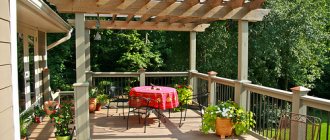When Europeans first discovered Chinese gardens, they were amazed by their originality and charm. The Chinese school of landscape art was completely unusual and unlike anything they were used to in Europe. There were neither neatly trimmed lawns, as in the English style, nor the clarity of lines inherent in the principle of regularity of French gardens. In China, the highest value is nature, which even in a small garden they try to reproduce with maximum accuracy, and in its most harmonious manifestation. In a native Chinese garden there may be not only plants, but also mountains, rivers, lakes - even in miniature - it doesn’t matter. The main thing is that the created garden helps a person understand and feel the harmony between himself and the surrounding nature.
Philosophy in the design of the green zone
A Chinese garden is most often a landscape garden in which each architectural element has its own symbolic meaning. A feature of the green zone can be called its characteristic hierarchy, the relationship of subordination between individual elements, with the obligatory observance of balance and harmony in the spirit of Feng Shui.
A garden with the mood of the Celestial Empire is the result of the efforts of man and nature, while man-made elements (buildings, sculptures, small architectural forms) surprisingly harmoniously become elements of the landscape, so that the artificial is sometimes not so easy to distinguish from the natural.
The influence of feng shui
Feng Shui provisions must be taken into account when planning a garden; the teaching determines its concept:
- harmony between all elements and stylistic devices used;
- the design necessarily provides for a dominant, the center of the composition, which determines the appearance of the entire territory;
- all elements used (plants and compositions from them, sculptures, lamps, etc.) have their own meaning.
Mood concept
In a garden created according to Chinese philosophy, there is always a pronounced center in the form of a dominant composition, and the remaining elements are located around it. Although gardens in this style have a single concept, there are many interesting ramifications. One of them is called “laughing gardens”. They are distinguished by rich colors and a wide color palette. Moreover, even such elements as buildings, paths, alleys are made in bright colors.
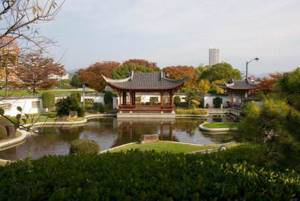
“Laughing Gardens” are philosophically and artistically contrasted with “menacing” ones, which are a reflection of the formidable power of unbridled elements. Their peculiar beauty and harmony is expressed in the form of twisted trees, cascading waterfalls, and boulders of stone ready to collapse at any moment.
“Idyllic garden” is another type of emotional state of the Chinese garden. All elements of the composition fulfill the task of establishing calm and peace in the soul, which is facilitated by dim colors, the calming surface of the pond, on an island in which you can retire in a cozy gazebo. It is noteworthy that all three of the above moods can be present in one green zone.
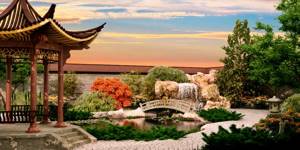
Chinese landscape design style is not afraid to play with space. An excellent illustration of such a game is “picture in a frame,” when through a figured hole in the wall you can observe a strictly defined, stylistically complete, self-sufficient section of the territory, and the visual essence of this can only be seen through this hole—the “frame.”
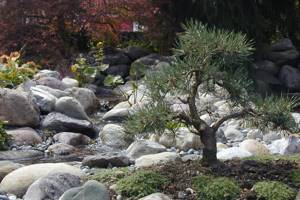
Stylistics of Chinese gardens and parks
Few parks or gardens in China are complete without elements of topiary art - sculptures and clipped paintings of plants. Topiary art is used in the design of relief hedges, borders, and flower beds. Interestingly, the vegetation is planted in such a way that the design is not only colorful and complex, but also three-dimensional.
Modern park construction in China has adopted the tradition of plant sculpture from the Americans, when a plant is planted inside an iron frame. Until it covers the entire metal base, the meaning of the sculpture is conveyed through the iron structure. This technique is called “new topiary”. The main feature of the “new topiary” is the play and interaction of different geometric shapes.
Typical garden elements
It is difficult to imagine a garden area in the Chinese style without buildings in the form of small architectural forms - gazebos, pagodas, observation decks, from where it is best to admire the landscape and observe the harmony of its elements with each other. The figured or ordinary wall surrounding the garden is also one of the characteristic features.
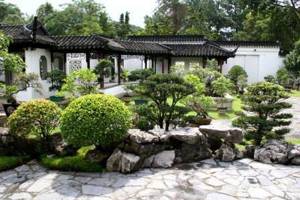
Paths and paths in a Chinese garden do not tend to run in straight lines.
Landscape design in China is accustomed to dealing with spacious areas; to realize all its plans, it requires large areas. It is worth considering that transforming a site into a garden in a similar style will require a large amount of work.
History of creation
The ancient Chinese garden not only has centuries of rich culture, but also unique features. It has existed for more than five thousand years. Executed in various styles, the ancient types of Chinese gardens were considered the best among the existing three systems of structural parks in the world. This is how they are today.
The history of Chinese gardens dates back to the Shang and Zhou dynasties. Then they were called “yu”, which meant “closest to the landscape”. It was a beautiful place for socializing and playing. During the Han Dynasty, a Chinese garden was built as a villa and was called "yuan". Here emperors could relax and discuss state affairs.
The main idea that the Chinese garden represents is the “creation of the natural world” in miniature. When creating it, the natural landscape with all the features of the geographical area is used as much as possible. This approach can still be observed today in many national parks, especially when it comes to imperial or monastic Chinese gardens.
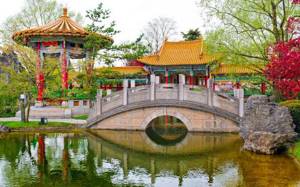
Plant selection
In China, breeding work has always been at a high level; many bred varieties of flowers were endowed with their own symbolic meanings and influence on the formation of a favorable environment according to Feng Shui. Plants, according to landscape designers of the Celestial Empire, create not just beauty, but something uniquely beautiful. Flowers for a Chinese garden are chosen to be visually spectacular and at the same time sophisticated. There should not be too many of them; greenery is often planted around so that the whole picture gives the impression of sophistication.
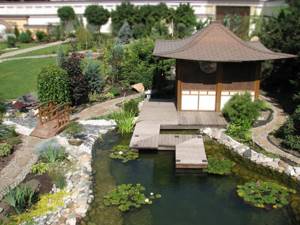
In a Chinese garden you can usually see peonies, bulbous roses, climbing roses, and various types of beautifully flowering fruit trees.
Modern Chinese parks are urban paradise
The profession of a gardener in China dates back to the pre-Christian era, therefore, they continue to actively build parks even now, even in megacities. City parks began to be actively built after China became the People's Republic. Many city parks have maintained their adherence to ancient traditions in Chinese landscape design and architecture. Some parks combine antiquity and modernity. There are also Chinese gardens and parks that are fundamentally designed to exclude the peculiarities of Asian culture.
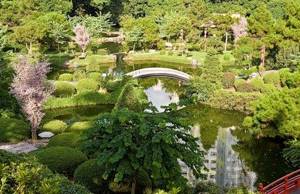
Daguanyuan Park
The most famous parks, which clearly demonstrate the traditions of modern park construction, are the Daguanyuan (Grand View Park) parks. The parks have the same name, but are located in two different cities: Shanghai and Beijing. They are an illustration of the famous masterpiece of eighth-century Chinese literature, The Dream of the Red Chamber. The landscape of the gardens recreates the area described in the work. For greater reliability and accuracy of reproduction, not only architects and designers were involved in the construction of the park, but also historians and literary scholars.
The modern park "Hehuachi" (Lotus Pond) was built on the basis of a reservoir, so water occupies two-thirds of the area of the entire park. Almost all residents relax in this park, as it is located in the very center of the city. Eastern Venice attracts tourists from all over the world. The park has a lot of flowering vegetation, as well as poplars, willows, pine trees, and cedars. All gazebos are located on the banks of reservoirs so that visitors can admire the blooming lotuses.
Solutions for a garden in the style of the Celestial Empire (photo)
Chinese style concept in landscape design
It obeys the strict requirements of the teachings of Feng Shui:
- Naturalness. The line between nature and the result of the landscape designer’s work should be practically invisible.
- Accounting for cardinal directions. Without exception, all components are carried out so that the garden changes and remains beautiful while the sun makes its way across the sky.
- A single center of the entire composition, turning it into a single whole. A pond, sculpture or flowerbed located in the center determines the appearance of the entire site.
- New views at every step or multidimensional space of the site. The views change as you move through the garden.
THE IMPORTANCE OF WATER IN A CHINESE GARDEN
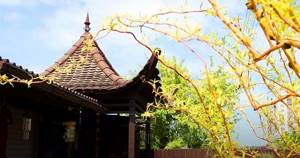
The water element (more than half of the territory) appears in two qualities. The main reservoir, serving as a “mirror of heaven” (the embodiment of peace), is located in the center of the garden. The remaining ponds embody the second quality - eternal movement, fluidity and change.
Chinese lanterns, pagodas, and tsukubai bowls are also located next to the water surface.
We dug four artificial reservoirs for different purposes: deep (for wintering fish), for irrigation, and shallow ones for water lilies and other aquatic plants.
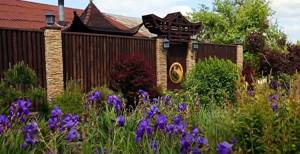
ROLE OF STONE
Stones balance the elements of water and wood, small architectural structures.
Natural flagstone was used for paving the paths. The pond, surrounded by paths made of mosaic pebbles, was decorated with gravel and boulders.











